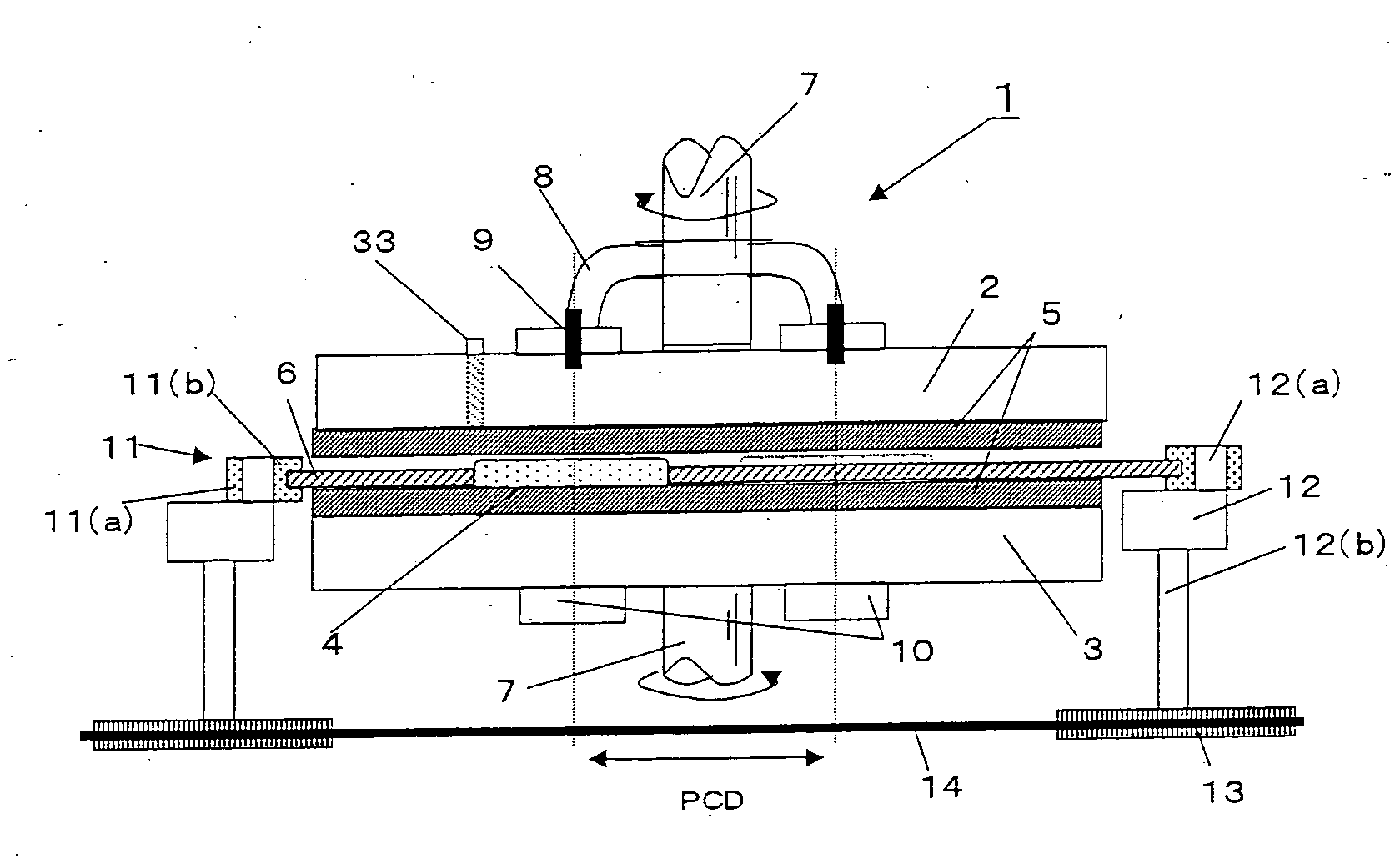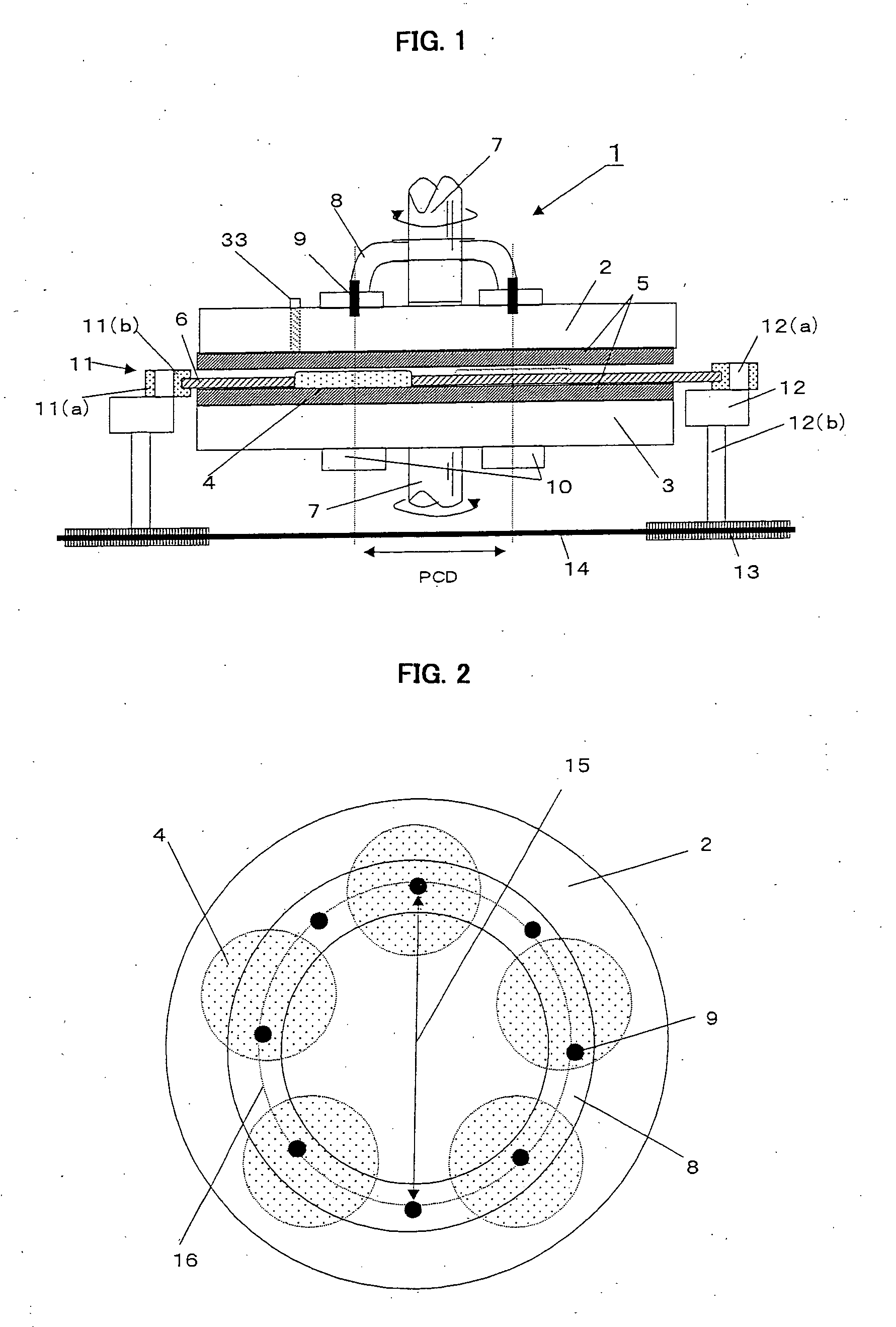Double side polishing device for wafer and double side polishing method
a polishing device and wafer technology, applied in the field of double side polishing devices for wafers and double side polishing methods, can solve the problems of affecting the polishing performance the change of the polishing ability and other factors of the polishing pad attached to the upper and lower turn tables, and the inability to maintain the quality of the wafer under varying polishing conditions, etc., to achieve excellent responsiveness in response, control the shape of the wa
- Summary
- Abstract
- Description
- Claims
- Application Information
AI Technical Summary
Benefits of technology
Problems solved by technology
Method used
Image
Examples
example 1
[0183] A double-side polishing apparatus was used in which the PCD of upper turn table load supporting points and the PCD of centers of the wafer holding holes on the carrier plate (centers of wafers held by the carrier plate) were coincident at 600 mm and in which the carrier plate performed a circular motion not accompanied by its rotation, with the average position of pitch circles formed by centers of wafer holding holes on the carrier plate coincident with the position of pitch circle formed by load supporting points of the upper turn table during polishing, as shown in FIG. 1.
[0184] Using the double-side polishing apparatus, five silicon wafers having diameter of 300 mm (one batch) were first inserted into respective wafer holding holes of the carrier plate (carrier plate having five wafer holding holes) so as to be rotatable. Each wafer was pressed at 200 g / cm2 by the upper and lower turn tables to which soft non-woven cloths (polishing pads) were attached.
[0185] Then, the ...
example 4
[0199] Twenty batches of silicon wafers were repeatedly polished while controlling the turn table shape through adjustment of slurry supply amount using a wafer double-side polishing apparatus as shown in FIG. 9 in which the PCD of upper turn table load supporting points and the PCD of centers of the wafer holding holes on the carrier plate (centers of wafers held by the carrier plate) were both set to 600 mm and in which the carrier plate performed a circular motion not accompanied by its rotation, with the average position of pitch circles formed by centers of wafer holding holes on the carrier plate coincident with the position of pitch circle formed by load supporting points of the upper turn table during polishing.
[0200] Five silicon wafers having diameter of 300 mm (one batch) were inserted into respective wafer holding holes of the carrier plate (carrier plate having five wafer holding holes) so as to be rotatable. Each wafer was pressed at a pressing force of 200 g / cm2 by t...
example 6
[0206] Twenty batches of silicon wafers were repeatedly polished as example 6 while controlling the turn table shape through adjustment of slurry supply amount using a four-way wafer double-side polishing apparatus as shown in FIG. 11 in which the PCD of upper turn table load supporting points and the PCD of carrier plate centers were both set to 800 mm.
[0207] First, a total of 15 silicon wafers having diameter of 300 mm (one batch) were inserted into three wafer holding holes formed on each of the five carrier plates. Each wafer was polished with pressed at a pressing force of 200 g / cm2 by the upper and lower turn tables, to which soft non-woven cloths (polishing pads) were attached. The slurry used was that in which polishing abrasive grain consisting of colloidal silica of 0.05 μm in grain size was dispersed in alkali solution with pH 10.5. The initial slurry supply amount was set to 5.0 liters / min. In example 6, twenty batches of wafers were repeatedly polished without replacem...
PUM
| Property | Measurement | Unit |
|---|---|---|
| diameters | aaaaa | aaaaa |
| pH | aaaaa | aaaaa |
| diameter | aaaaa | aaaaa |
Abstract
Description
Claims
Application Information
 Login to View More
Login to View More - R&D
- Intellectual Property
- Life Sciences
- Materials
- Tech Scout
- Unparalleled Data Quality
- Higher Quality Content
- 60% Fewer Hallucinations
Browse by: Latest US Patents, China's latest patents, Technical Efficacy Thesaurus, Application Domain, Technology Topic, Popular Technical Reports.
© 2025 PatSnap. All rights reserved.Legal|Privacy policy|Modern Slavery Act Transparency Statement|Sitemap|About US| Contact US: help@patsnap.com



